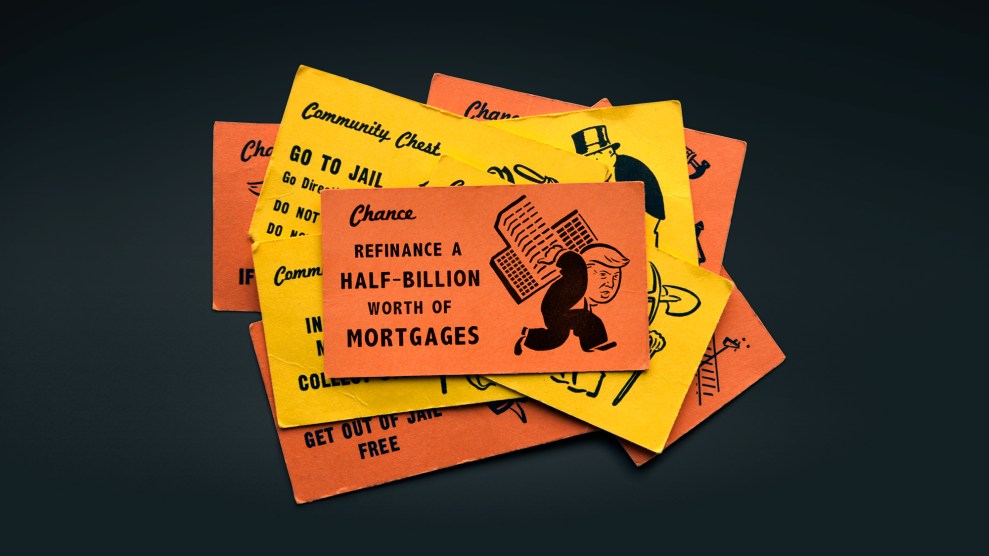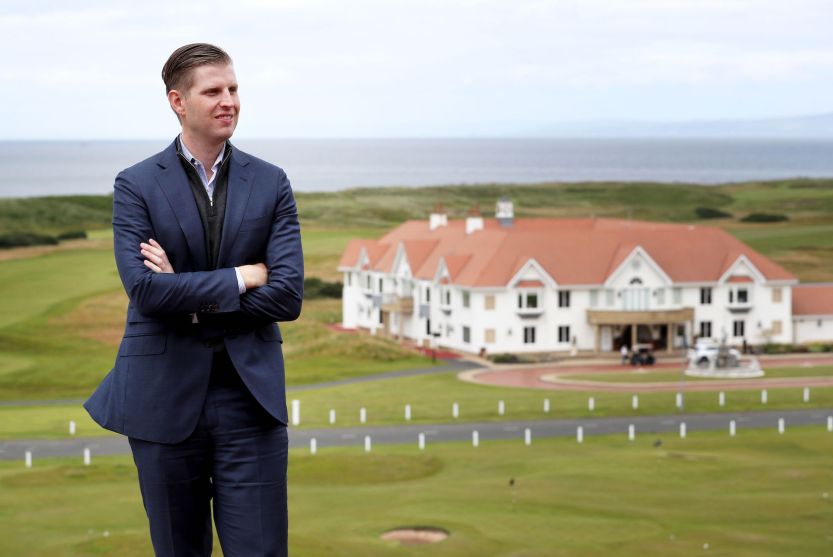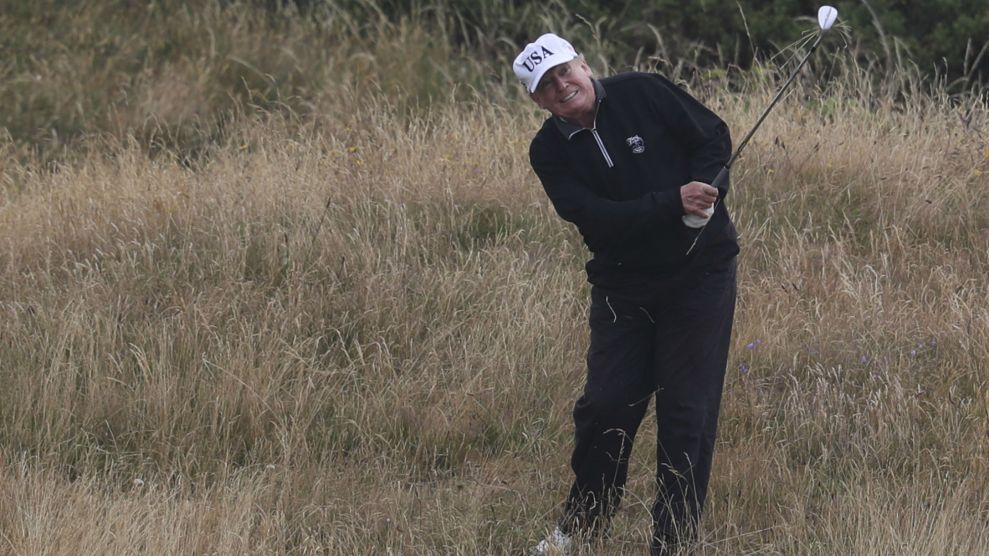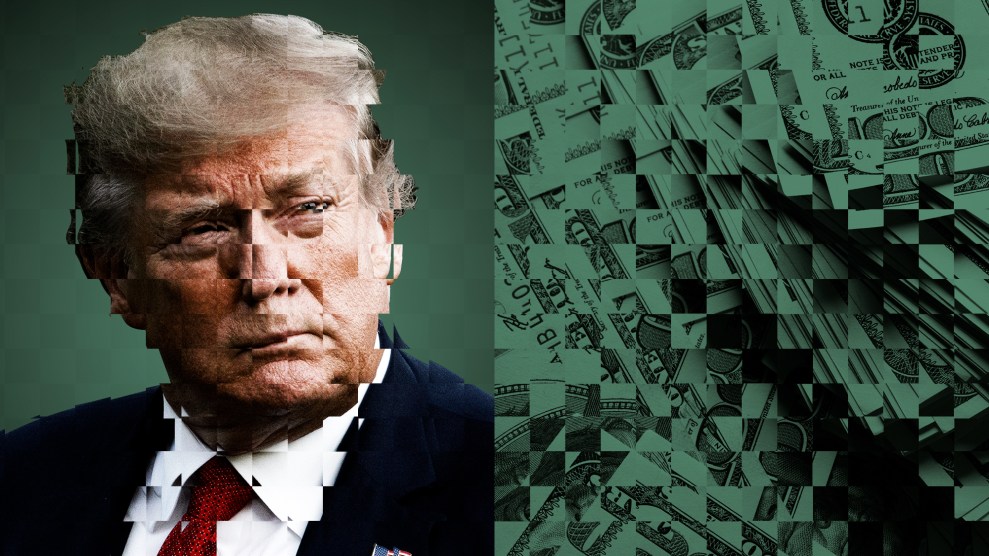In 2006, Donald Trump purchased a 1,400-acre swath of the old Menie Estate in Aberdeenshire, a rambling property situated on Scotland’s rugged and remote northeastern coast. Trump pledged to develop a world-class golf resort replete with luxury villas there, and he vowed to revitalize the region with more than a billion dollars of investment. Though not an obvious location for a glitzy development—the area is mostly known for its offshore oil industry, and it rains more than a third of the year—Aberdeenshire was to be the beachhead of the mogul’s ambitious plan to insert his family name among the storied golf courses of Scotland, the birthplace of the sport, and attain for his brand the kind of old-world prestige that had eluded Trump in the United States.
The development seemed particularly important to Trump, whose mother hailed from the Isle of Lewis, a far-flung island in the Outer Hebrides. And it was unlike anything he had undertaken before. He often licenses his name to projects financed by others. And the self-proclaimed “king of debt” typically takes out large loans to finance the ventures he does bankroll. In this case, Trump’s company proceeded with the development on its own. And it says it paid for everything in cash.
Such was also the case for Turnberry, the historic golf resort, an hour south of Glasgow, that Trump purchased in 2014 for $60 million. His large expenditures in Scotland were notable because they came during a rocky financial stretch for Trump. The year before purchasing the Aberdeenshire estate, he was ousted as CEO of his thrice-bankrupted casino business; in 2008, he defaulted on a large Deutsche Bank loan tied to a development in Chicago.
Like other Trump wagers, his Scottish gamble has so far not worked out. Both resorts are bleeding millions annually. Meanwhile, he and his company have spent years viciously skirmishing with various locals and government agencies that resisted Trump’s plans to build luxury housing on the fringes of the resorts, which the Trump Organization seems to view as vital to profitability.
If business was lackluster before, it’s dismal now that the coronavirus pandemic has all but halted the Scottish golf season, at least as far as international travelers are concerned. To make matters worse, as Trump’s hospitality empire grapples with the fallout of COVID-19, it also faces a series of maturing debts, loans amounting to nearly a half-billion dollars, which need to be paid down or refinanced over the next four years.
Recently, a new—and perhaps bigger—threat to Trump has emerged in Scotland. Scottish lawmakers are pushing to peer into Trump’s finances using an anti-money-laundering statute typically employed against kleptocrats, oligarchs, and crime kingpins. Their question: Where did the hundreds of millions Trump poured into his Scottish courses actually come from?
Early promotional materials for Aberdeenshire carried what purported to be the Trump clan’s baronial crest—three lions under an armored fist brandishing a spear and surrounded by a flourish of red and white feathers.
It was, no surprise, a fake. Trump had cribbed the coat of arms from Joseph Edward Davies, whose wife had built Mar-a-Lago and who had legitimately been granted the crest in the 1930s. He had made only one minor change, erasing the Davies family motto of “integritas” (integrity) and replacing it with “Trump.” He had used the doctored crest for years to peddle all sorts of products—from ties to beach towels—and it was plastered across his US properties.
But that didn’t fly in Scotland.
For centuries the country has had an office devoted to making sure people do not claim someone else’s family name. And after it determined Trump was indeed displaying a stolen coat of arms, he was barred from using it. The episode foretold Trump’s subsequent misadventures in Scotland, a country particularly resistant to his brand of flimflam.
In Aberdeenshire, Trump initially won over locals with his plans for a sprawling upscale golf community containing multiple courses ringed by tastefully designed homes. He vowed to bring 6,000 jobs to the area. But fierce opposition formed when Trump revealed his plans to build the first course atop environmentally sensitive sand dunes. In late 2007, local planners rejected Trump’s proposal, but after Scotland’s then–First Minister Alex Salmond met with Trump, the Scottish government stepped in to overrule the local authorities. Construction proceeded. But when Salmond refused to block a planned offshore wind farm in view of Trump’s course, Trump went ballistic. He wrote Salmond a series of bizarre letters in which he insisted that if Salmond allowed the wind farm, he would destroy any chance of Scottish independence, and “your economy will become a third world wasteland that global investors will avoid.”
At a hearing in 2012, a member of the Scottish Parliament asked Trump, who appeared in person, for evidence that the turbines would damage Scottish tourism.
“Well, first of all, I am the evidence. I’m more of an expert than the people you’d like me to hire…I am considered a world-class expert in tourism,” Trump declared without missing a beat, as the room broke out in laughter and audience members rolled their eyes.
Trump eventually sued the Scottish government but lost so resoundingly that in 2019 he was ordered to pay its legal fees. The wind farm had been completed the previous year.
Meanwhile, Trump became embroiled in petty disputes with his neighbors in Aberdeenshire. At first, these were the type of NIMBY contretemps that are to be expected when a large development is proposed in a small community. But with Trump, whose business credo is “get even with people,” things quickly escalated.
The Menie Estate had been sold off in parcels over the years, requiring him to purchase it piece by piece. But a group of homeowners whose properties formed small enclaves amid the larger estate defied Trump’s entreaties to sell.
David Milne was one of them. In 1992, he purchased a decommissioned coast guard watch station on the property. It was government-owned, Milne says, and “dead cheap.”
“It was an empty, cold industrial building,” Milne recalls, describing how he wandered through the structure, eventually making his way to a tower with a panoramic view of the North Sea. “I came upstairs and got into what is now my office and looked out at the view and it was just a case of, ‘Wow! Yes, I’m having this!’ And the deal was done. I put down my roots and never moved. There’s literally my blood, sweat, and tears in this building in various walls. Heartaches, heartbreaks, success, pain, and triumph. I’m proud of this building, proud of this house.”
Perched on a hillock overlooking what would become the 18th hole, Milne’s home stood dead in the center of Trump’s vision of a pristine golf course for elite jet-setters. “I want to get rid of that house,” Trump declared during a visit to his course in 2010, adding, “We’re trying to build the greatest course in the world. This house is ugly.”
Milne and his wife rejected Trump’s purchase offer, which Milne describes as laughably low. Trump raised his price slightly and attempted to sweeten the deal by offering Milne, who rarely golfs, a lifetime membership at the club and access to its spa. After the Milnes rebuffed that offer, Trump’s lawyer asked local authorities to take their home—and those of others who refused to sell—by compulsory purchase (the UK version of eminent domain). Milne and several other neighbors fought off the attempt. He contends Trump then tried to harass them out of their properties.
Construction work severed Milne’s water and phone lines. Milne says the Trump Organization also encircled his property with trees to block his view, attempted to construct a giant berm hemming him in, and threatened to knock down his garage for allegedly being built over the property line (it wasn’t). Ultimately, Trump’s company erected a fence around the Milnes’ property—then billed the couple for the work.
Milne tossed the bill and has delighted in telling the story ever since—especially since Trump made his famous campaign pledge in 2016 to “build a great, great wall on our southern border” and make Mexico pay for it. The Milnes now fly a Mexican flag (next to the Saltire, the Scottish flag) outside their home, within view of the Trump clubhouse.
Trump’s heated squabbles with Milne and other neighbors had a sideshow quality—bizarre, ham-handed, and often self-defeating—but there was something stranger still about the amounts of cash he has dumped into Aberdeenshire and Turnberry.
He spent nearly $13 million purchasing the land for the Aberdeenshire course, and as much as $50 million developing the property. All, apparently, in cash. According to Trump, after purchasing Turnberry in 2014 for $60 million from a holding company owned by the government of Dubai, he dished out as much as $200 million rehabbing the venerable property.
Neither has ever turned a profit. Turnberry, considered one of the top Scottish courses, has seen its golf business decline. When it opened in 2012, Aberdeenshire was touted as a technically interesting and highly challenging course, but it has struggled to attract crowds. Milne says that over the last few years he’s found it so sleepy it rarely bothers him.
“To be quite honest, it’s not a major issue to me,” he says. “The car park is very rarely more than half full.”
The size of Trump’s wealth is a source of great debate, but two things are fairly well known—the period between 2006 and 2014 included some of his lowest points, financially speaking, and even in the best of times, the amount he splurged in Scotland would be a ton of cash for him to have on hand, let alone spend so freely. And Trump made these Scottish investments amid a $400 million cash spending spree, documented by the Washington Post, in which he also purchased a golf club in Ireland, five courses in the United States, and several pricy homes.
The New Yorker estimated that Trump would have spent half his available cash on the purchase of Turnberry alone, concluding there wasn’t “enough money coming into Trump’s known business to cover the massive outlay he spent” renovating the property.
And the mystery deepens. Martyn McLaughlin, a Glasgow-based reporter for the Scotsman newspaper, discovered that in 2008 Trump approached a Scottish bank asking for a $63 million loan to buy and renovate a historic hotel overlooking the final hole of St. Andrews, the most famous golf course in the world. The terms he proposed were so ludicrously favorable to him that bank executives concluded Trump was asking for a “free loan,” and doing business with the developer was “too risky.” Meanwhile, Trump was touting his “very strong” cash position and his representatives were telling the Scottish public that he had more than $1 billion available to spend in their country. (The Trump Organization did not respond to questions from Mother Jones.)
This February, a group of Scottish Parliament members began making the case that Scotland should use an investigative tool under UK law called an Unexplained Wealth Order (UWO) to scrutinize Trump’s transactions. It can’t be wielded against just anyone; it’s designed to make inquiries into the finances of “politically exposed persons” suspected of money laundering. It has been invoked several times in London; for example, examining how the wife of a jailed ex–Azerbaijani government official had managed to afford a 16 million-pound shopping spree at Harrods.
Patrick Harvie, a Scottish Parliament member and co-leader of Scotland’s Green Party, has led the campaign for a UWO against Trump. “This is not someone who inspires confidence in sound finances and sound business,” he says. “The fact that there are many allegations floating around that the US authorities have investigated, whether it’s in relation to Russia or his political dealings domestically—you don’t have to sniff the air very long to see there’s something that smells.”
Harvie cited a report by Avaaz, a global nonprofit activist group, that has been key to the campaign. It highlights Trump’s association with people scrutinized by US law enforcement for illicit financial transactions, including Paul Manafort, his campaign chair who was convicted of tax and bank fraud, and Michael Cohen, who was sent to prison for campaign finance crimes committed on Trump’s behalf.
“Without more information from Mr. Trump, there is reasonable doubt that his income during the time of Turnberry’s purchase and renovation would have been sufficient to cover all of these expenditures,” the report concludes.
McLaughlin puts it in simpler terms. “The abiding mystery is why Mr. Trump and his companies seem to relish in spending exorbitant amounts of money and losing exorbitant amounts of money here,” he says. “Given all the difficulties the Trump Organization has had, why is it so determined to throw more money at it?”
One theory is that Trump hoped to own a course that hosts a “major”—one of the top-tier professional golf tournaments each year. Turnberry used to regularly host the British Open, but it hasn’t since Trump took over. “He desperately wants a major. That was the big idea,” says sports writer Rick Reilly, who has golfed with Trump and in 2019 published the book Commander in Cheat: How Golf Explains Trump.
Indeed, the New York Times reported this summer that in 2018 Woody Johnson, a Trump donor who was appointed as US ambassador to the United Kingdom, told several colleagues that the president had asked him to make inquiries with the British government about steering the British Open to Turnberry. According to the Times, Johnson did raise the question with the Scottish secretary of state, against the advice of career diplomats; nothing came of it.
Reilly says Trump ruined any chance of getting the British Open with his racist and sexist conduct. “Of all the people in the world that aren’t going to put up with a fool, it’s the Scots,” he says. “They’re just such a no-nonsense people and they see him for what he is: He’s a big blowhard con man who is trying to tell them what they know isn’t true.”
Trump’s alleged entreaty to his UK ambassador is not the first time his administration has been accused of taking action to boost Turnberry’s lackluster business. Last year, Politico reported that Air Force flight crews stopping for overnight layovers in Scotland were being sent to Turnberry’s hotel—a luxury establishment close to an hour away from the airport—even though cheaper lodging was available nearby. The Air Force, which spent nearly $184,000 at Turnberry, denied any wrongdoing.
If Trump’s Scottish ventures seemed ill-fated before, things are about to get much worse. In 2018, the most recent year for which numbers are available, both courses lost more than $15 million combined. And that was a good year. A golf industry expert familiar with Trump’s operations says he expects that 2020 revenues at Turnberry and Aberdeenshire will be down 80 to 90 percent from 2018.
Gordon Dalgleish, president of PerryGolf, which organizes golf tours for well-heeled clients in the British Isles, says the pandemic has brought Irish and Scottish golf tourism to a standstill. At many of the iconic Scottish courses, including Trump’s, “well north of 50 percent” of the patrons are wealthy Americans. “If you sat in the lobby at Turnberry, you’d hear a lot of American accents,” he says.
Not this year. In May, Scottish authorities allowed golf clubs to reopen, but under strict guidelines: Clubhouses were shuttered, caddies can work for golfers from just two households a day, and players are barred from congregating on the course before, during, or after play. But the far bigger impediment is that, as of July, the United Kingdom required international travelers to quarantine for two weeks. “It’s pretty hard to sell a one-week trip until there’s no quarantine,” Dalgleish notes.
Last fall, local authorities rejected Trump’s initial proposal to build a golf community at Turnberry, but in July, McLaughlin revealed that the Trump Organization had quietly drawn up plans for an even more ambitious expansion—one that could cost hundreds of millions of dollars. Meanwhile, Aberdeenshire officials have finally approved Trump’s plan to begin building a second course along with luxury homes and “five-star hotel cottages.” The cost, according to Trump, is almost $200 million.
Dubbed the Trump Estate, promotional materials show rows of quaint dwellings crowded along elaborately landscaped lanes. Homes range in price from about $370,000 for a two-bedroom cottage to $1.6 million for a five-bedroom mansion.
But with revenues so low, the money needed to complete the project—let alone a major development at Turnberry—may be hard for the Trumps to come by. McLaughlin also says he doesn’t understand how luxury homes in an out-of-the-way region of Scotland, known for blustery North Sea winds and offshore oil, make sense.
“Quite how they’ll have a viable business scheme out of that, I’m not sure,” he says. “Who pays hundreds of thousands of pounds for a family villa in the northeast of Scotland that’s got the corrosive brand of Trump attached to it?”
Reilly agrees. “Buying a place there would be like flying to Italy to go to an Olive Garden,” he says. “It’s insane. Who would do that?”
McLaughlin says that at an open house for prospective buyers last winter, the interested parties seemed mostly foreign. “Which raises the question, Who is investing? Who is giving money to the president’s company? It’s the most explicit opportunity to put money into the Trump Organization in return for property.”
Of course, if Trump’s finances continue to suffer, he may have to offload the courses before he builds a single villa. “He’ll have to. It’s a matter of when,” says the golf industry expert. “He doesn’t have the cash flow.”
David Milne says he hasn’t heard from the Trumps in years. But one early evening 11 years ago, at the height of the planning battle over Aberdeenshire, Milne says he heard a knock at his door. He opened it to find Donald Trump Jr. and then–Trump Organization executive George Sorial. They had visited before, Milne says. “They quite often showed up and tried to discuss something. Usually they were told to go away. None of them have ever been over the doorstep.”
That evening, they weren’t there for a discussion; just to deliver a message—or, as Milne understood it, a threat. “Remember, whatever you say and whatever you do, we usually get what we want,” Milne recalled being told.
“Not this time,” he responded.
















